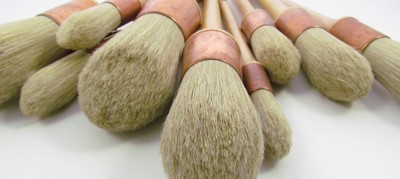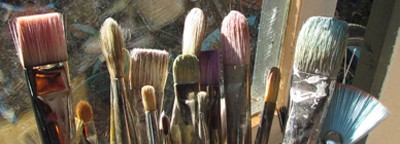Why Are Some Brushes More Expensive?

The first thing that will determine the cost of a brush will be the hair type. Sable hair, taken from the Sable Mink, is a natural, limited resource so will be priced to reflect this.
Similar hair types, such as squirrel, come close to the qualities of Sable – great water-carrying ability, spring and inclination to point – but, as it generally grows to a longer length, will be cheaper in the larger sizes. The only time that very large sized Sable brushes are available is when there has been a very cold winter and the animal has had to produce longer hair to keep warm. The rarity of the large sizes in Sable will therefore show in the price.

The average synthetic hair is the work horse – durable, economic, can be used for practically all media but will not excel at watercolours and some oil techniques. Some synthetic brushes, however, use a combination of highly engineered fibres to mimic the sought-after qualities of natural hair so the cost for these will rise.
Traditional Hog brushes from pig hair have, although natural, a plentiful source and so can be a cheaper option for oil painting. However, there are two types that are the best hair and they are the Chung King and Jyukeis Hog so, if you are looking for these hair types, you will need to pay a little extra.

And there is a whole raft of natural hair types under names such as pony, camel or badger which are basically a mix of all kinds of low-grade natural hair which will be cheap and cheerful.

The next consideration is the quality of the hair. Top of the range sables use the very best hair from the tip of the tail. Belly hair, whilst still good, is going to be courser and so given a lower rating and priced lower as a result.

Top quality Synthetics succeed in mimicking the qualities of natural hair and give much better results as a consequence. As you would expect with clever science and great results, you need to pay a bit extra for these than for your average nylon brush.

Hog hair can be very course and twisted and the rougher, the better! A Hog with more ‘split ends’ or flags, holds more paint and stands up better to the course weave of some canvas. Holding more paint allows for a smoother application.

Finally, there is the important factor of construction. A good brush, whatever the hair type, will have a considerable length of hair clamped inside the ferrule to keep it secure. Skimping on the length of the hair to keep costs down is one of the major reasons for hair loss in a brush. The quality Artist’s brush will also have a seamless ferrule made of a material that will resist bending, loosening or tarnishing. Some of the very best brushes have gold-plated ferrules to ensure that no tarnishing ever occurs.

The handle will be formed from a good wood or composite with a coating that will not crack or peel and be fixed to the ferrule with a strong adhesive and a crimp.

But the most important part of the construction, will be how the hair is put together. Quality brushes are still hand finished to ensure that the finished brush has a good shape. Rounds will have the hairs carefully chosen by length to lie together in a way that produces a good belly that then naturally tapers to a fine point whilst flats will have hairs of the same length chosen to form a perfect uniform end.

Brushes, at the other end of the price spectrum though, will be machine trimmed into the required shape and so will not have the same control, longevity and clean mark-making ability.
Most brushes are dressed with a gum arabic or similar solution to keep them in shape when they are on display but, whilst a quality brush will retain its shape for its lifetime, a cheap brush may flay and separate after that perfect, dressed point is used a few times.

However, once you know what to look for, you will soon be able to tell the difference between Artists, Students and kids brushes and know what to expect from each type and how much they would expect to be. The price generally points to the quality but, with these tips, you will know when you are looking at a fantastic brush at a bargain price or a bargain that is too good to be true!! See our article on choosing the right paper to find the perfect surface for your mark making with Watercolour.

